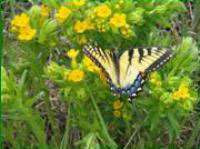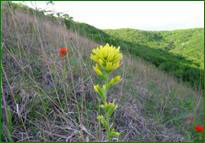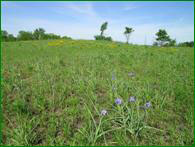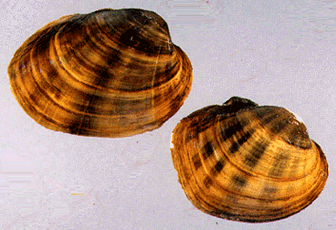Mississippi River Endangered Resources
Prior to European settlement, the Coulee Region and the Mississippi River corridor supported a mosaic of prairie, oak savanna, oak forest and maple-basswood forest on the upland with floodplain forest and marshes along the large rivers of the region. Today a large number of the Endangered and Threatened Species of the Western Coulees and Ridges Region and the Mississippi River corridor consist of plants and animals that depend on the remnants of these natural communities.
Efforts have been made to protect and preserve some of these special habitats in Wisconsin through the Endangered Resources and Natural Areas programs. In addition, other sites have been identified through the Land Legacy Program.
The Mississippi River corridor

Prairies are one of the most endangered types of natural communities in the upland portion of the Mississippi River corridor. Prior to settlement, the presence of fire maintained prairie and oak savannas. But much of this native prairie was a casualty of the plow, while other patches gradually converted to forest due to the control of wildfires. Along the Mississippi River, there are currently two types of prairie remnants that are of special concern, goat prairies and sand prairies.
Goat prairies (dry prairies)

The bluffs on the Wisconsin side of the Mississippi River valley have predominately southern or western exposures which were once covered by dry hillside prairies and oak savannas. These prairie remnants, often referred to as goat prairies were named because they are to steep to plow and only fit for a goat to graze,
have managed to persist because of a combination of factors that result in drought conditions.
Goat prairies are usually located on slopes exposed to prolonged periods of intense sunlight which, during the growing season, results in a very hot, dry microclimate. They are also invariably found on thin soils overlying bedrock. The combination of dry microclimate and thin soils creates a desert-like environment that can be inhospitable to all but the most drought-tolerant species, thus the slow invasion of woody species into those prairies.
However, given enough time and in the absence of fire, even the driest and steepest of bluff prairies will yield to the slow advance of shrubs and trees. Numerous goat prairies on the bluffs bordering the Mississippi River are now almost covered by stands of red cedar interspersed with birches. As a consequence, plants and animals that depended on these special habitats have declined considerably.
Sand prairies

River terraces, formed along the Mississippi River during the end of the ice age, were historically covered with vast expanses of sand prairie. Because the terraces provide level land they have been used as locations for communities and intensively used for agriculture. The remaining parcels of viable sand prairie are threatened by development.
Some of the state threatened and endangered species found these types of prairies include:
Birds
- Bell ’s Vireo - threatened
- Greater Prairie Chicken - threatened
- Loggerhead Shrike - endangered
Reptiles and amphibians

- Blanding’s Turtle, Wood Turtle - threatened
- Eastern Massasauga Rattlesnake - endangered
- Ornate Box Turtle - endangered
- Western Slender Glass Lizard - endangered
- Wood Turtle - threatened
For more information on any of the species listed above see endangered and threatened species of the Western Coulees and Ridges Region [PDF] and select the category and species.
The Mississippi River
Although the Mississippi River still supports an amazing variety of aquatic life, there are species of fish, freshwater mussels, turtles and birds that have been impacted by the extensive changes that have occurred to the river over the last 100 years.
Fish
The most dramatic change was the result of the building of the locks and dams to maintain the 9-foot navigation channel. During this process, gravel bars and shallow places were removed or flooded and ultimately the free-flowing river was changed into a system of navigation pools or reservoirs. These changes significantly impacted species such as lake sturgeon, paddlefish, blue sucker, crystal darter and skipjack herring.
Fish species listed as state endangered or threatened include:
- Skipjack Herring - endangered
- Crystal Darter - endangered
- Blue Sucker - threatened
- Bluntnose darter - endangered
- Starhead Topminnow - endangered
- Goldeye - endangered
- Black Buffalo - threatened
- Longear Sunfish - threatened
- Shoal Chub - threatened
- River Redhorse - threatened
- Black Redhorse - endangered
- Greater Redhorse - threatened
- Pallid Shiner - endangered
- Pugnose Shiner - threatened
- Gilt Darter - threatened
- Paddlefish - threatened
Freshwater mussels
In addition, other changes that occurred as a result of the dams (including water depth, velocity of currents and water temperature) negatively affected the Freshwater Mussels of the Upper Mississippi River.
Freshwater mussels listed as state threatened or endangered include:

Endangered Higgins eye pearly mussel.
- Rock Pocketbook - threatened
- Spectacle Case - endangered
- Purple wartyback - endangered
- Butterfly - endangered
- Higgins Eye Pearly Mussel - federal and state endangered
- Yellow and slough Sandshells - endangered
- Monkeyface - threatened
- Wartyback - threatened
- Buckhorn - threatened
- Winged Mapleleaf - federal and state endangered
Birds
Many of the bird species listed as endangered and threatened species of the Western Coulees and Ridges Region are also found in the Mississippi River Corridor. The most widely known success stories include the bald eagle, peregrine falcon and trumpeter swan. The bald eagle and trumpeter swan have been delisted, however, the peregrine falcon is still listed as endangered.
Peregrine falcons on the Mississippi River
Wisconsin status: endangered.
Peregrine falcons had essentially disappeared from this part of the Mississippi River by the late 1950s due to the effects of DDT. This pesticide was passed through the food chain, eventually reaching the peregrine falcon. The concentration of chemicals in the peregrine’s system caused females to lay eggs with very thin shells which either didn’t hatch or were crushed under the weight of the incubating adult.
Recovery efforts along the Mississippi River began in the mid-1970s using traditional cliff sites as release locations but the attempts were unsuccessful as the released birds were picked off by great horned owls. Nesting attempts on the cliff sites in the 1980s failed for similar reasons.
Consequently, the recovery efforts moved away from the more natural habitat and used urban release sites such as tall buildings and eventually smokestacks of power companies located along the river. Peregrines were very successful on the smokestacks and built up their numbers to the point where young birds, looking for a place to nest, started to move back onto the traditional cliff sites overlooking the Upper Mississippi River.
Bald Eagles on the Mississippi River - a success story!
The bald eagle was declared endangered in 1973 but is no longer state listed as endangered or threatened. Today the bald eagle is a familiar resident along the Upper Mississippi River during nesting season. In 1972 there was one nesting pair; now there are well over one hundred. The river also serves as a well-known wintering site. In 2006, over 1000 eagles were counted in 117 miles of river during the annual midwinter aerial count conducted by the Wisconsin DNR.
The bald eagle was taken off the endangered list in Wisconsin in 1997 and was taken off the federal list in 2007.
